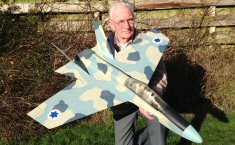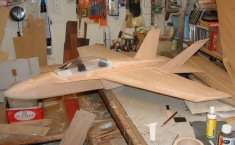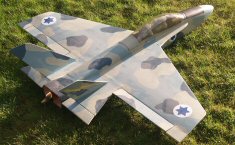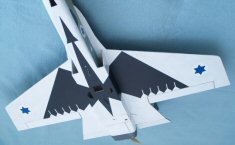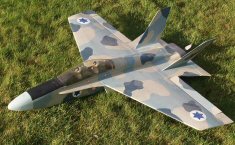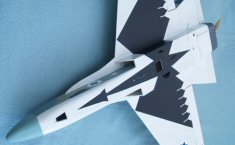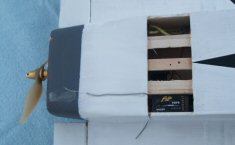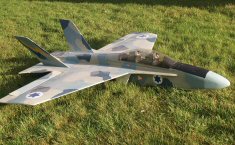|
|||
|
|
|
||
| View Shopping Cart |
| Home |
| Guides Available |
| About the Author |
| FAQs |
| Testimonials |
| Articles |
| Contact Andrew |
| Terms & Conditions |
| Mailing List |
| Links |
 |
 |
Get more high quality
articles like this one, absolutely free
with every Gibbs Guides e-magazine. Click
here!
Mike White's Dominator 44
Article by Mike White
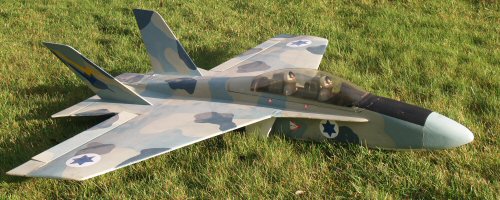
Introduction
The Dominator 44 is the fifth in a line of models designed and built over
the past 15 years or so, all of which have the same wing planform. The
model is not a scale design, but it does bear some resemblance to the
F15 fighter. The 44 inch span model is of all-sheet construction and is
great fun to fly!
Wings
The wings are made entirely from 3/8" (9mm) sheet balsa. They are
simple and quick to make - first the wing planform is cut out, then the
sheet balsa is then simply planed to an airfoil section.
Fuselage
The fuselage construction is a simple all balsa box. This is divided into
three compartments to form the central fuselage assembly and the two outer
ducts. Various balsa formers give stiffness, and the rearmost former to
which the motor is attached is made from ply.
| Mike White and his Dominator (click image to enlarge & get more information). | The Dominator 44 during the building process (click image to enlarge & get more information). |
Power system
To my mind there is no point in building a fighter type model if it is
to be flown around like a trainer. No sir, no way!! My usual power loading
for this type is around 125 watts per pound of model which gives sprightly
performance, although this model has a rather better power loading.
The motor chosen for this model was the EMP B3650/06. This is an inrunner with a Kv of 2,300, rated for a maximum of just over 1,000 watts. The motor is intended for use with 3S-5S lipo batteries. In this model, the motor is supplied with a 3S 4,000mah 30C battery.
When turning an 8x6 APC i/c (gas) prop, the motor draws around 59 Amps, for a power consumption of around 725 watts. The ESC is an 80 amp opto unit. This is housed in one of the side ducts, which also provides it with adequate cooling. The battery is cooled by air entering via a NACA duct under the nose. The warmed air leaves the model on the underside near the finger launching holes.
The battery is fixed to a 3mm liteply base by a Velcro strip and another
on the ply base. As `belt and braces` another Velcro strip goes around
the base and is fixed to the top of the battery.
| The Dominator features a twin tail. | With a colour scheme like this, there's no mistaking which way up the model is! |
Control
The RC gear is all powered by a 1,000mAh hydride battery. Control is throttle,
aileron and elevator.
For belly landing models I like to use metal geared servos. I’ve used TowerPro 90MG servos for this model, one for each surface. So far, no servos have suffered stripped gears.
Finish
The finish is doped tissue, a little filler and Humbrol enamel paint brushed
on.
Setting up
Finding the best balance position was a little worrying at first on all
of these models. In the end it was achieved by using the formula for finding
the balance of a delta wing, plus a little bit added forward for the long
nose and side wings, plus a little bit added aft for the tail area plus
a little bit more added forward for mum; just to be on the safe side………very
scientific!
| Another shot of the good-looking Dominator. | The Dominator's intakes. |
Flying
Up until now, the model has always been bungee launched. However one day,
when the wind is up a little and I have some more flying experience with
it I may get someone to do a hand launch for me. This should be no problem,
really, as there is so much thrust available at full throttle the model
should get away well.
The model has a thin, fast wing. The leading edge has a small radius, so this means the stall has to be carefully avoided especially during the approach and in low speed flight. To this end some down flap is mixed with low throttle position which, after some trial (and happily no errors) has proved helpful.
| Dominator receiver bay. | Dominator witing patiently for its next mission. |
Performance
The total effective wing area is 680 square inches and the flying weight
is 4lb 3oz. This results in a wing loading of a very acceptable 16 ounces/sq.ft.
The power loading is 180 watts/pound.
You can see the other models which lead up to the Dominator 42 here.
| Dominator technical data | ||
| Span | 1,120 mm | 44 inches |
| Length | 000 mm | 00 inches |
| Wing Area |
0.00 sq m | 3.47 sq ft (500 sq in) |
| Flying Weight | 0,000g | 4lb 3oz (67oz) |
| Wing Loading | 00g/dm | 16 oz/sq ft |
| Flight Battery | 3S 4,000 mAh LiPo | |
| Motor | EMP B3650/06 (Kv 2,300) | |
| Prop | 7x6, approx 18,000 rpm | |
| Max Power | 59A / 725 Watts | |
| Power Loading | 000 W/kg | Approx 180 W/lb |
| Endurance | Approx 8min | |
| Control functions | Elevator, ailerons & throttle. 1,000mAh 4-cell NiMH receiver battery | |
Get more articles like
this one absolutely free with every
Gibbs Guides e-magazine. Join
the mailing list!
